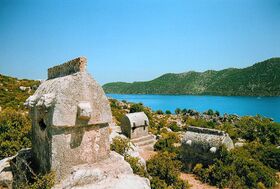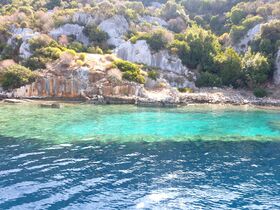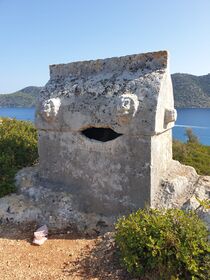Sunken City und die Totenstadt Simena (Kekova Inseln)
(dg) Simena (Ancient Greek: Σίμηνα) war eine antike Stadt, etwa einen Kilometer von dem kleinen Hafen Üçağız. Für Kenner der Antike spielte dieser kleine Ort zwar nur eine geringe Bedeutung. Dafür beherbergt er heute einen antiken Friedhof, der sich sehen lassen kann. Vom Berghang herab schmiegen sich dutzende lykische Pfeilergräber, von denen einige noch heute im Meer stehen (Bild 03). Diese Lage und, dass Simena Teil einer größeren, heute aber weitgehend unter Wasser liegenden Siedlung war (Sunken City), machen diesen Ort besonders wertvoll.
Die Region Kekova ist 260 km² groß und umfasst die Insel Kekova, die Dörfer Kaleköy und Üçağız sowie die vier antiken Städte Simena, Aperlae, Dolchiste und Teimioussa. Grabinschriften und Münzfunde weisen darauf hin, dass die Stadt bereits im 4. Jh. v. Chr. existierte. Ein Teil der antiken Stadt ist heute im Meer versunken und im Wasser liegen Überreste der Titus-Therme. Zu sehen ist ein kleines Theater auf der Akropolis innerhalb der späteren Festung, das in den Felsen gehauen ist. Auch liegt der frühere Hafen auf der Insel Kekova liegt heute im Meer versunken. Man kann nur noch die Hafenmauer sehen.
Wirklich spektakulär sind die Gräber, die sich nahe des Forts sowohl an Land als im Wasser befinden. Sie machen Simena zu einem der bekanntesten Orte der Lykischen Kultur im Südwesten der Türkei.
Herodot behauptete, dass die Lykier ursprünglich von Kreta kamen, sich Termilen nannten und erst durch den Athener Lykos, den Sohn Pandions, ihren Namen erhielten (VII, 93). In Anbetracht dessen schlussfolgerte die bekannte israelische Sprachwissenschaftlerin Margalit Finkelberg, dass die Sprache von Linear A entweder der direkte Vorfahr des Lykischen oder ein eng verwandtes Idiom sei. In diesem Zusammenhang verwies sie auf Herodots Aussage der Herkunft der Lykier von Kreta. Die Lukka-Leute kämpften schon auf Seiten der Hethiter bei der Schlacht bei Kadesch (ca. 1.274 v. Chr.). Griechische Kolonien gab es – im Gegensatz zum östlicheren Südkleinasien und zur westkleinasiatischen Küste – offenbar kaum. Vermutlich gelang es den Lykiern, Kolonisationsversuche erfolgreich abzuwehren. Die lykische Sprache starb hingegen schon im 3. Jh. v. Chr. aus; andere kulturelle Eigenheiten der Lykier hielten sich bis in die Spätantike.
Lykische Funde aus der Zeit vor dem 6. Jahrhundert v. Chr. sind sehr selten und reichen maximal ins 8. Jahrhundert v. Chr. zurück. Daher konnte die Archäologie bisher kaum Licht in die Frühgeschichte Lykiens bringen. Der eigentümlichste Grabtyp ist das Pfeilergrab (bzw. auch als Grabpfeiler bezeichnet), das in archaischer und klassischer Zeit verbreitet ist und offenbar der dynastischen Elite vorbehalten war.
Auf Simena kann man sich diesen Grabtyp in vielen Ausführungen anschauen. Die Bilder geben dafür einen guten Einblick in die Vielfalt der Ausführungen.
Simena beherbergt eine Vielzahl dieser Monumente, die vom Berggrat bis ins Meer reichen. Sie machen diesen Ort im Archipel von Kekova-Island zu einem ganz besonderen. //
Simena is home to a variety of these monuments, stretching from the mountain ridge to the sea. They make this place in the Kekova Island archipelago very special.Genau gegenüber an der Nordküste von Kekova befinden sich die Ruinen der „Sunken City“. Diese Siedlung (Dolchiste) ging bei einem Erdbeben um 200 n. Chr. unter. Heute sieht man an den Hängen vereinzelt noch größere Hausruinen und die im Meer versunkene Hafenmauer. //
Just opposite on the north coast of Kekova are the ruins of the “Sunken City”. This settlement (Dolchiste) was destroyed in an earthquake around 200 A.D. Today you can see even larger house ruins on the slopes and the harbor wall that has sunk into the sea.Das Pfeilergrab der Lykier ist ein beeindruckendes Bauwerk. Es war aufgrund seiner komplexen Architektur nur der Oberschicht der Lykier vorbehalten. Das größte heute nach erhaltene Grab steht heute in Xanthos und ist fast 9 m hoch! //
The pillar tomb of the Lucians is an impressive structure. Due to its complex architecture, it was reserved only for the upper class of Lucians. The largest surviving grave today is in Xanthos and is almost 9 m high!Die Besitzer sparten nicht an Geld, denn viele dieser Pfeilergräber weisen aufwendige Ornament oder sogar Reliefs auf. Dieses hier im Bild zeigt auf dem Sarkophagdeckel sogar Löwenköpfe, was eine gewisse kulturelle Verwandtschaft in den Vorderen Orient verraten lässt.//
The owners did not save money because many of these pillar graves have elaborate ornaments or even reliefs. This one in the picture even shows lion heads on the sarcophagus lid, which reveals a certain cultural connection to the Near East.An anderer Stelle steht dieses aufgebrochene Grab, was einen Blick ins Innere gewährt. Wie schon beschrieben haben die Lykier keine reichhaltigebn Funde des täglichen Lebens hinterlassen. Das Wenige kennt man nur aus den aufwendigen Grabanlagen. //
This broken-open grave stands elsewhere, allowing a look inside. As already described, the Lucians did not leave behind any rich finds of daily life. What little is known is only known from the elaborate grave complexes.Der gesamte Bergrücken von Simena ist von Pfeilergräbern bedeckt. Sie stehen aufgereiht, fast wie auf einer Perlenschnur. Meist sind sie Ost-West orientiert. Sie stehen aber auch z.T. kreuz und quer in der Landschaft. //
The entire Simena ridge is covered by pillar tombs. They are lined up, almost like on a string of pearls. They are usually oriented east-west. But they are also sometimes found all over the landscape.Simena lädt wirklich jeden zum Verweilen und Staunen ein. Hier ein schönes Beispiel für eine Grabanlage, die romantisch auf einer Anhöhe zwischen Bäumen steht. Kekova ist wirklich einen Abstecher wert. Das Zusammenspiel zwischen türkisblauem Meer, Natur und antiker Architektur ist atemberaubend. //
Simena really invites everyone to linger and marvel. Here is a beautiful example of a grave complex that romantically waits for its visitors on a hill between trees. Kekova is really worth a visit. The interplay between the turquoise sea, nature and antique architecture is breathtaking
Sunken City and the necropolis Simena (Kekova Islands)
Simena (Ancient Greek: Σίμηνα) was an ancient city about a kilometer from the small port of Üçağız. For connoisseurs of antiquity, this small place was of little importance. Today it houses an ancient cemetery that is worth seeing. Dozens of Lucian pillar tombs nestle down the mountainside, some of which still stand in the sea today (Image 03). This location and the fact that Simena was part of a larger settlement (Sunken City), which is now largely under water, make this place particularly valuable.
The Kekova region is 260 km² and includes the island of Kekova, the villages of Kaleköy and Üçağız, and the four ancient cities of Simena, Aperlae, Dolchiste and Teimioussa. Grave inscriptions and coin finds indicate that the city was already existed in the 4th century B.C. Part of the ancient city has now sunk into the sea and the remains of the Titus Baths lie in the water. You can see a small theater on the Acropolis within the later fortress, which is carved into the rock. The former harbor on the island of Kekova is now sunk into the sea. You can only see the harbor wall.
The graves that are located near the fort, both on land and in the water, are truly spectacular. They make Simena one of the most famous places of Lucian culture in southwest Turkey.
Herodotus claimed that the Lucians originally came from Crete, called themselves Termiles and only received their name from the Athenian Lykos, the son of Pandion (VII, 93). Given this, noted Israeli linguist Margalit Finkelberg concluded that the language of Linear A was either the direct ancestor of Lucian or a closely related idiom. In this context she referred to Herodotus' statement about the origin of the Lucians from Crete. The Lukka people fought on the side of the Hittites at the Battle of Kadesh (ca. 1.274 BC). In contrast to the more eastern southern Asia Minor and the western coast of Asia Minor, there were apparently hardly any Greek colonies. The Lucians probably managed to successfully fend off attempts at colonization. The Lucian language, however, died in the 3rd century B.C.; Other cultural peculiarities of the Lucians persisted into late antiquity.
Lucian finds from before the 6th century B.C. are very rare and date back to the 8th century B.C. at most. Therefore, archeology has so far been unable to shed much light on the early history of Lucia. The most peculiar grave type is the pillar grave (or grave pillar), which was common in the Archaic and Classical periods and was apparently reserved for the dynastic elite.
On Simena you can see many versions of this grave type. The pictures provide a good insight into the variety of designs.







